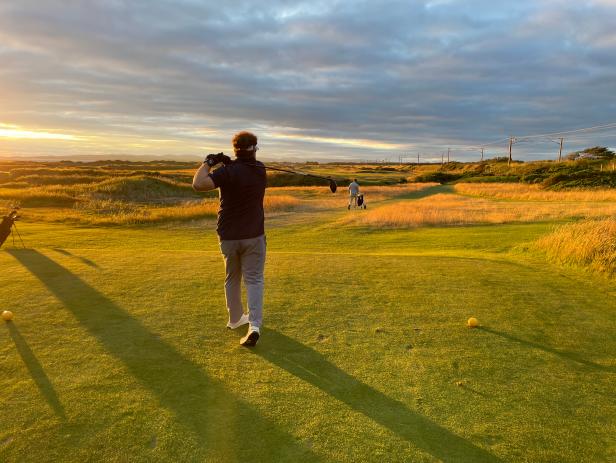Golf
Links Golf Broke Me: An American plays for the first time in Scotland

TROON, Scotland — Two of the most boring things in the world are making excuses and forcing other people to listen to your travel woes. Still, now that a few days have passed and I can speak from a place of calm reflection, I want to note for the record that there are several individuals and entities in the airline industry that deserve to be guillotined, and they are responsible for the 40-hour fever dream that finally deposited me in Scotland as a ravening, bewildered lunatic on the verge of either a nervous breakdown or a homicide. A nice man named Mariusz drove me from the Edinburgh airport to Ayr, and I suspect he released a cloud of anesthetic gas in the back seat as an act of mercy, because for the first time in two days I slept fully. When I woke up 90 minutes later and staggered into my AirBnB, I had just one hour before my tee time at Western Gailes—my first ever round of links golf, and my first round overseas.
Believe me, there are no good guys in this story … except for Mariusz, and his part is already over. I might be the worst guy of all, give or take a baggage handler—I was given the opportunity to live out the dream of so many golfers for two straight days, I didn’t have to pay a dime, and I was still incapable of enjoying myself to the expected degree. It goes down as a dispiriting failure to live in the present moment coupled with a shocking lack of gratitude, and the sad part is I could see it all unfolding like a nightmare.
I don’t even know why I’m writing this—I made some vague promises to my editors, but they’re nice enough to let me out of it, and might have forgotten entirely if I kept my mouth shut and pretended it never happened. Maybe it’s a confession, or maybe I want to do penance by making you hate me.
But! Despite the lowlights and the self-loathing and the sneaking sense that I may be too cynical and basic to appreciate almost anything nice, I think—to quote myself and every other golfer who has ever lived—I might have found something there at the end.
I’ll say this for my potentially terminal sense of wonder: Every inch of land left me in awe.
We were just a few miles north of Troon, along the Firth of Clyde, and the lightly rolling linksland was everything you’d dream of in your Scottish golf fantasy … the swaying wheat-colored fescue, the darker shrubby gorse and all the flowers that grow in little clusters among the high grass; beach rose, meadow vetchling, yarrow, ragwort. The wind blew, but reasonably. There was no rain.
Like a lot of other courses around Troon, Western Gailes dates to the tail end of the 1800s, when the Duke of Portland built a railroad from his coal mines in Kilmarnock to the west coast, where he used the natural harbor at Troon to ship it to the rest of the world. Golf in Scotland was an east coast game for centuries—that’s where the trade with the low countries flourished, and where stick-and-ball antecedents like chole in Belgium, or kolven in the Netherlands, inspired the Scottish game. Golf did not travel quickly westward, partly because it rains here all the time, and in the prime golf season from December to March—back before they could mow the grass and play in summer—the people of means would go eastward anyway, and play in Edinburgh and St. Andrews. So while early golfers were hacking in the east as early as the 1400s, the west was hundreds of years behind, and places such as Western Gailes, like Royal Troon and Prestwick, the site of the first British Open, were relative newcomers. Put it this way: as far as Western Gailes is concerned, there are older American courses.
None of which made it feel any less epic, or historic … I was primed for something special. My partners were three other media members, two of whom I won’t throw under the bus by naming, and one of whom was my friend Adam Schupak of Golfweek. He was late for our 5:40 tee time, but the nice people at the course told him he could join us when he arrived. He was only a few minutes behind, but he promptly teed off on the wrong course—the adjacent Glasgow Gailes Golf Club—made birdie on the opening hole by himself, took a selfie with the flag, and finally realized the mistake he’d made. Meanwhile, on the actual first hole, I hit a competent drive, semi-chunked my approach, but was surprised to find it on the front of the green and two-putted for par.
That, by the way, is a lesson I never fully internalized—the greens here are not especially fast, but the land is fast, and if your approach shot hits the actual green, it will run gleefully off the back. Over and over during my two links rounds, I took dead aim by force of habit and sent ball after ball careening into the fescue. The only time I held a green is when I accidentally hit the approach short by chunking or mis-clubbing. This lack of adaptation became a theme. In what you can call some form of thoughtless American arrogance, I made zero concessions to the style of play; I chipped when I should have putted, failed to hit low shots into the wind except when I topped the ball, and never landed an approach short on purpose. It was the golf equivalent of visiting a foreign country and eating every meal at McDonald’s.
On hole two at Western Gailes, fortified by the par, I striped another drive, and hit a 5-iron to six inches. It was close enough that I could film myself knocking it in one-handed for my first links birdie. I was over the moon, invigorated, enlivened. The romance of the place swept through me. I began to dream.
Some context, from a 12 handicap: Ten days earlier, I had set a personal record by shooting 75 on my home course in North Carolina. It was a magical day, only the second time I had ever broken 80 and the realization of a goal I never thought I’d achieve, which was playing nine holes under par with a 35 on the back. The hot streak came as the result of a grip change, and I thought I had figured out the art of ball-striking permanently. In particular, I pumped out 13 drives, and all 13 found the fairway or the light rough. Why couldn’t I do it again here?
I had forgotten three things. First, you have never figured out golf, ever. Second, total exhaustion lurked. Third, Western Gailes is much harder than my home course. None of this was sustainable; I had been set up perfectly for a hard fall.
The driver went rogue first. I hit a series of high, disgusting fades, and unlike at home, when you hit into the rough you only have about a 23-percent chance of finding your ball. We had no caddies, and I’m bad at paying attention to landing areas in the first place, so the penalties came fast. I handled it fine at first, because this type of miss was completely new to me, and it had to be a fluke. Then it kept happening. My game is predicated on accuracy off the tee—irons have traditionally been the worst part of the show, and while I can save the odd par here and there with above average chipping, if I’m not in the fairway off the tee, it will eventually catch up with me. Here, there was no “eventually” about it—the fade/slice persisted, and I was too tired to figure out why. The annoyance turned to anger, which turned to swearing, which turned to sulking.
I think I was OK company, and I still had moments of appreciation for the course, for nature and for the moment. I learned that the magic hour in Scotland comes at about 9:15 p.m., and when it arrived we marveled at the view of the water and the undulant land illuminated by the setting sun. In the background, we could see the mountainous Isle of Arran, and the dark knob of an island that was Ailsa Craig, where they made curling stones, harbored persecuted Catholics and, now, give sanctuary to puffins and gannets. A spiritual something ran through me like a shiver, brief but intense.
Then I resumed being mad. Every hole brought a new penalty. The driver was irreparable. I hit ambitious shots out of the rough that trickled into the burn (it was called “Montgomery Burn,” but I believe it predates The Simpsons). I yanked irons. I putted like an idiot. My legs ached. My back ached. I’m not too proud to admit that walking all over an airport for two days wearing the same clothes had resulted in some unfortunate chafing. The fact that they didn’t have carts, which is part of the undeniable charm of the place, wounded me. On repeat, I kept thinking, I am so tired.
We finished around 10:20 p.m.—you can play absurdly late here in July—and I tapped in for a 99, although that 99 came with assessing a one-stroke penalty every time I lost a ball in the fescue, which is not correct. It was the worst round of golf I’ve played in at least two years. Worse, I understood that the poignancy of the moment—the confluence of several loves, including the love of golf, of Scotland and of history—had pretty much passed me by.
It was going to get worse.
In 1848, the legendary St. Andrews pro Allan Robertson spotted his apprentice Tom Morris on the course playing a new gutta percha ball. Worse, Morris was playing well. That irked Robertson, in no small part because he made the old featheries and the gutta percha was cutting into his business. The fact that an employee defied him proved intolerable, the two got into a big fight, and Robertson either fired him, or Morris quit. (A probable underlying source of tension is that Robertson, long considered one of Scotland’s best golfers, was now a clear second fiddle to his apprentice, and carefully dodged him in one-on-one matches.)
Three years later, a new course out west called Prestwick hired Morris to do essentially everything, from course design to maintenance to selling equipment to teaching. In that capacity, Morris helped found the Open Championship, the first 12 iterations of which were held at Prestwick. The ever-ambitious Royal and Ancient Golf Club of St. Andrews recognized his genius and hired him back in 1864 at a high salary, but the 12-hole course at Prestwick was already part of history.
Today, it has been expanded to 18 holes, and the northernmost point of the course sits just steps away from the southern terminus of Royal Troon. It is a quirky little beast—on the first, you have to hit a mid-iron into a landing area in front of trouble, followed by a half-blind approach into the green. On the par-3 fifth, called “Himalayas,” you face a completely blind shot over a giant hill, aiming at strips called “sleepers” that correspond with your tee color and praying you’ve taken the right club. Elsewhere, tall poles serve as aiming points for hidden flags, and there are more elevation changes than a place like Western Gailes, so that even though it’s just steps from the sea, it feels like some combination of a links and inland course, heightened by the fact that you can’t see the water due to the raised road running along the western edge.
In other words, the place is weird, and I wish I had a chance to play it 20 times in a row. On Wednesday, though, after one of those paradoxical nights where you’re so exhausted you can’t sleep, and after a day working and walking at the Open I came in to the 5:10 tee time genuinely wishing I could go home and rest, but feeling that to bail out would be unforgivable. For the second day in a row, I committed the private sin of wishing for a cart.
Golf media flooded the place like a plague of locusts, and it struck me again how informal Scottish golf felt. At an American course of this stature, you’d have a massive sprawling clubhouse, a long drive up some tree-lined avenue, a show of dropping off the bag, checking in, and etc., while here at the venue that hosted the very first major championship ever played, you park in an unassuming lot, buy a ball marker and tee off. I didn’t even see a starter.
Schupak and I teed off in a twosome (“two-ball,” by their lingo) lodged between two foursomes. Once again, I had a competent first two holes, with a bogey on one and a missed five-footer for birdie on two. Once again, I had a moment of false hope—the story you’re reading now was on my mind, and I badly wanted to write that I’d broken 80, or at least come close. That brought us to the par-5 third, which required a 220-yard shot off the tee. I grabbed 5-wood, and hit the same stupid fade that had dogged me at Western Gailes, straight into the deep fescue. I took a second ball, and did it again. I tried to console myself with the knowledge that I only use old balls I find in the woods … at least I didn’t have to watch the dollars vanish into the fescue one by one.
It didn’t work. The doubts and self-pity flooded. I didn’t want to be here. I needed sleep. I was in the middle of golf heaven, but mentally a million miles from appreciating it. I hit a third shot far left, directly into a bunker.
“I listened to your Van de Velde podcast,” he said.
He can sense I’m down, I thought, and he’s going to compliment me to cheer me up.
“At one point you said ‘Mark Brooks’ when you meant ‘Mark James.'”
As a kind of punishment, I kept an accurate score for the hole: 12. I did not write down another score the rest of the day.
When the driver came out of the bag, the ball continued to drift right. The holes dragged on. The pace was abysmal. I checked the course map to see when we’d come back around to the clubhouse: Not until 14. I got a text from friends playing Western Gailes, reporting that the pace was even worse there, and they were leaving after nine to get dinner. I started planning how I’d pitch an early exit to Schupak, or how I’d possibly write about it later without invoking total scorn.
And I began to wonder: What is wrong with me, that I care so much about my golf skill—a sport where I’m barely above average at my absolute best—that I can’t shut it off and enjoy my surroundings? Why is there a part of me that has become such a boring homebody that I’d rather be playing at my home course in 100-degree heat? Have I lost my sense of adventure?
Or am I just really ****ing tired?
On the eighth hole, I wondered if I was throwing my right arm at impact and thereby keeping the club face open. I decided to focus on the feeling of a dominant left arm, swinging easily but purposefully through the ball. The first time I tried, the ball went straight.
Every drive I hit the rest of the day either found the fairway or drifted slightly left. The irons clicked immediately into place. The minute I put in the effort to solve my problem, I did. I made a beautiful par into stiff wind on the par-5 12th, with a straight drive, an ill-advised 6-iron that got brutalized by the wall of wind, a 4-hybrid to the front of the green, a short chip, and a tap-in.
The land was achingly beautiful. I stood on a stone bridge and looked south, taking in the water of the Pow Burn, the green expanse, and the town of Prestwick rising in the far background. I felt briefly calm.
But when 14 brought me back to the clubhouse, at around 9 p.m., I still wanted to leave. At that exact moment, my friends from Western Gailes pulled in the parking lot to pick me up. Schupak tried to convince me to stay—he made me promise to write that he stayed to the finish—but what I wanted was to have drinks and dinner with my friends. I felt the acute ingratitude in the early exit and dreaded admitting it to the world here in Golf Digest, but how long can we apologize for who we are, or what we feel in a given moment? There is a certain danger with an experience like Prestwick—you can spend your entire time thinking, “am I enjoying this enough?” and rob yourself of the simple pleasure that would avail if you weren’t trying so hard. You become a hostage to your own expectations.
By dinner, I had forgiven myself. I want to play links golf again, on my terms, but it is no crime if your emotions are tied to your level of play on the course, or if the appeal of a golf mecca sometimes pales to an average bed in a Scottish AirBnB. This is the flawed truth of a flawed person, and if acceptance is elusive on the golf course, at least we can embrace it afterward, and admit to ourselves in a quiet moment what we really think, and who we really are.










